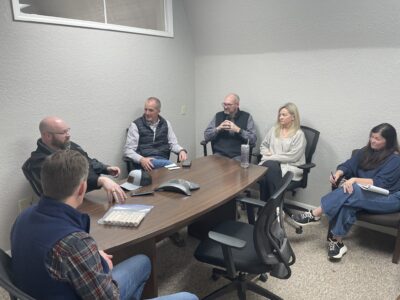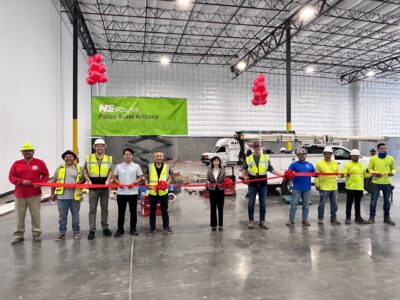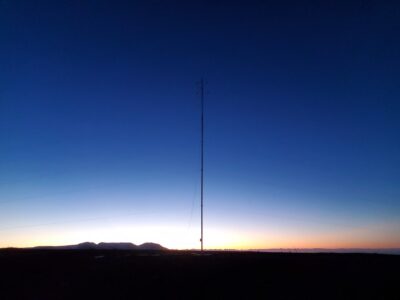Bill Gates revolutionized the personal computer when he founded Microsoft and created Windows software. Since stepping back from leading his company, he has helped vaccinate impoverished countries, championed civil rights along with his ex-wife, Melinda, and has served as an influence for tech entrepreneurs for the last quarter-century.
It seemed only natural that he would enter the clean energy industry. His nuclear power company, TerraPower, just broke ground on a modular reactor site in southwest Wyoming.
TerraPower, based in Bellevue, Washington, the home state of Microsoft, is creating a smaller, highly efficient nuclear plant to produce carbon-free electricity for 400,000 homes once online. Gates, the chairman of the board and founder, and several TerraPower executives traveled to Kemmerer, Wyoming, for the groundbreaking ceremony on June 10. The reactor will replace a retiring coal-fired power plant, which had served as one of Kemmerer’s largest employment centers.
“This groundbreaking represents the beginning of the next era of nuclear energy. The Natrium reactor is more than a design; it’s a plant coming to life that will support both the clean energy transition and our historic energy communities,” Chris Levesque, TerraPower president and CEO said in a press release.
“Our innovative Natrium technology will provide dispatchable carbon-free energy, gigawatt-scale energy storage, and long-term jobs to the Lincoln County community.”
Wyoming Gov. Mark Gordon was also in attendance. He expressed excitement for the nuclear plant, as the Cowboy State has reckoned with the surge in cleantech. He said that the Natrium reactor being built promises economic benefits to the Kemmerer-Diamondville area while reducing the state’s emissions.

Photo Courtesy TerraPower
“This project also demonstrates how good things can happen when the private and public sectors work together to solve problems,” Gordon said in a statement. “Advances made here will bolster Wyoming’s ability to produce another source of dispatchable power securely. In Wyoming, we know energy — and we will continue to provide it to help keep our nation competitive and safe.”
Natrium is a sodium-cooled fast reactor with a built-in gigawatt storage system. The molten salt coolant doesn’t require protective shielding like it would with light-water-cooled reactors. In case of emergencies, it can be cooled with air vents. Maximum output is listed at 345 megawatts (MW), and the storage technology can increase that to 500 MW.
The kicker with TerraPower’s reactors is the cost. Large reactors can cost billions to build, achieve federal oversight approval, and require years of maintenance. The last American reactors, the Vogtle Units 3 and 4 in Georgia, were the only nuclear projects built in the past 30 years and cost $35 billion. It was also seven years behind schedule. Seeking financing for these has become a challenge.
Gates has poured more than $1 billion into developing Natrium. He told The New York Times he’s not interested in making money from the venture.
For him, this is all about climate change and getting America off the coal and gas standard.
However, the plan seems likely to generate some profits. Levesque told The New York Times the molten salt battery storage allows TerraPower to sell renewable power back to utility companies. The U.S. Department of Energy also contributed $2 billion to cover construction costs, more money than they would commit for natural gas plants.
The reactor won’t be ready until 2030 and must also get approval from the Nuclear Regulatory Commission before it’s ready to provide power. Once online, it will be the first time in about 40 years that a modular reactor can serve as a commercial power plant.
The loss of the coal plant worried some that the local economy would take a huge hit, especially as it serves as one of the community’s main employment options. It won’t close until 2036, but concerns were mounting.
However, TerraPower says the project will create more than 1,600 temporary construction jobs. Once online, 250 permanent positions will open.
It’s expected to boost small businesses like coffee shops and restaurants with more workers traveling through the Kemmerer-Diamondville area. Local union workers are being asked to work on the project. The reactor can also produce petrochemicals, hydrogen, ammonia, and fertilizer.
Uranium sourcing is the big question mark hanging over the Kemmerer plant; a bipartisan bill was signed in May banning Russian uranium imports. According to the Washington Post, the new legislation could help because it unlocks $2.7 billion in funding for domestic uranium enrichment. In turn, the effort would specifically assist Centrus in expanding its enrichment facility in Ohio.
After the Russian invasion of Ukraine, TerraPower said it would not buy Russian uranium. This situation led to delayed plans as they looked for a new supplier — the original opening date was 2028. Gates and Co. are still looking for one; however, the new bill may speed things along.
The Nuclear Regulatory Commission still has other concerns about the reactor’s seismic activity resistance and waste dumping grounds.
Gates told The New York Times he welcomes the skepticism, and it’s understandable. It’s a financially rigorous project, with many moving parts and regulations needed. However, he believes in it, an attitude many cleantech entrepreneurs share. If the benefits outweigh the costs, it is worth it in Gates’s eyes.
“I’m proud of all the partners and people who helped get the most advanced nuclear project in the world built in Kemmerer, Wyoming,” he said in the groundbreaking announcement. “I believe that TerraPower’s next-generation nuclear energy will power the future of our nation — and the world.”





